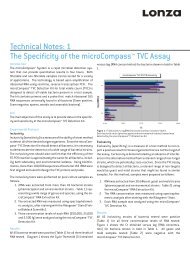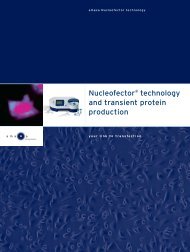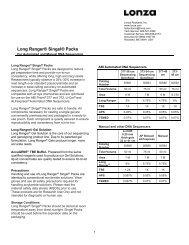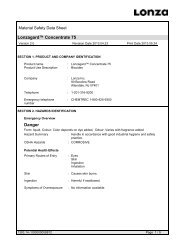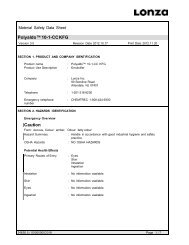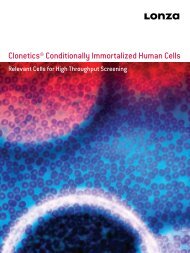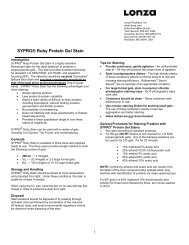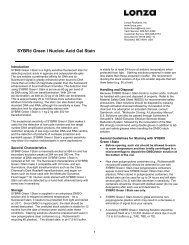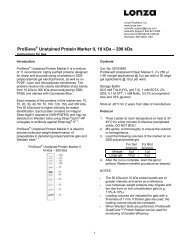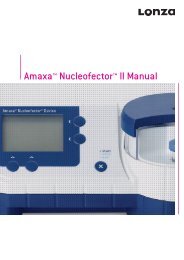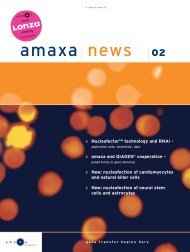amaxa news #10 - Lonza AG
amaxa news #10 - Lonza AG
amaxa news #10 - Lonza AG
You also want an ePaper? Increase the reach of your titles
YUMPU automatically turns print PDFs into web optimized ePapers that Google loves.
› Application Note<br />
A<br />
of transfected cells quantified (Figure<br />
1A, B). We reached transfection efficiencies<br />
of approximately 60% that allowed<br />
to perform biochemical experiments.<br />
Importantly the transfected neurons<br />
developed normally (Figure 1C, D). This<br />
allowed us to quantitatively downregulate<br />
Stau2 in neurons via RNAi. The<br />
levels and the specificity of Stau2 downregulation<br />
were assessed via western<br />
blot analysis (Figure 2A). The protein<br />
levels of Stau2 were significantly downregulated<br />
in shRNA transfected cells<br />
whereas the levels of the Stau2 paralogue<br />
Stau1 as well as that of the unrelated<br />
protein Septin7 remained unchanged.<br />
Moreover, nucleofection ® with mis-Stau2<br />
did not affect Stau2 protein levels,<br />
indicating that the down-regulation of<br />
Stau2 is specific.<br />
The extent of down-regulation in mature<br />
neurons was further controlled by<br />
immunocytochemistry (Figure 2B). 15 DIV<br />
neurons were co-transfected using the<br />
CaPi method with an expression vector<br />
encoding ECFP together with pSUPER<br />
vectors against Stau2, misStau2 and<br />
B<br />
C D<br />
o<br />
o<br />
A B<br />
o<br />
¬<br />
Figure 1: Hippocampal neurons are transfected efficiently via nucleofection ® .<br />
Hippocampal neurons were transfected with an shRNA construct against Stau2 and<br />
cultured in 6 cm cell culture dishes. After 3 DIV, neurons were fixed and analyzed to<br />
examine transfection efficiencies (B). The transfection efficiency reached up to<br />
60%. Neurons displayed normal morphology upon nucleofection ® (A). Higher<br />
magnification phase contrast (C) and fluorescence images (D) show the integrity of<br />
the transfected neurons. The arrow shows an outgrowing axon and the arrowheads<br />
indicate extending neurites with the typical growth cones at their tips. The inset in<br />
C shows the corresponding DAPI stained nucleus of the transfected neuron.<br />
RFP, respectively, and immunostained<br />
with Stau2 and Stau1 antibodies. Stau2<br />
staining was substantially reduced in<br />
neurons transfected with the shStau2<br />
plasmid but was abundant in neurons<br />
transfected with mis-Stau2 or RFP plasmid.<br />
The down-regulation of Stau2 did<br />
not affect Stau1 staining.<br />
Interestingly, down-regulation of Stau2<br />
caused a rearrangement of the actin<br />
cytoskeleton, which plays an important<br />
role in the maintenance and plasticity of<br />
dendritic spines. This effect was mirrored<br />
by changes in the morphology of dendritic<br />
spines from their characteristic mushroom-like<br />
shape to filopodia. In addition,<br />
it could be observed that the levels of<br />
PSD95, a key component of the postsynaptic<br />
density, were reduced in Stau2<br />
down-regulated neurons, indicating that<br />
there are fewer functional synapses<br />
than in normal cells. This hypothesis<br />
was borne out by electrophysiological<br />
recordings that indicate a reduction in<br />
synaptic transmission in Stau2 knockdown<br />
neurons 8 .<br />
As Stau2 has been implicated in dendritic<br />
› Page 9 › www.<strong>amaxa</strong>.com<br />
mRNA transport and since the actin<br />
cytoskeleton is rearranged upon Stau2<br />
down-regulation, it was further tested<br />
whether the levels of -actin mRNA<br />
b<br />
are changed in Stau2 down-regulated<br />
neurons. It was indeed observed that the<br />
-actin mRNA levels were reduced by<br />
b<br />
approximately 37%, indicating that<br />
Stau2 is important for the transport of<br />
this mRNA into dendrites 8 .<br />
Discussion<br />
The Nucleofector ® Technology is ideally<br />
suited to perform RNAi studies in postmitotic<br />
cells, such as hippocampal neurons.<br />
In contrast to other transfection<br />
methods, the high transfection efficiencies<br />
attainable with the nucleofection ®<br />
technique allow a proper analysis of the<br />
levels of Stau2 protein down-regulation<br />
by quantitative western blot analysis.<br />
In summary, this study showed that<br />
the down-regulation of Stau2 causes<br />
changes in dendrite morphology and<br />
suggests a role of Stau2 in the transport<br />
of b -actin mRNA into dendrites of hippocampal<br />
neurons.<br />
mock unr. mis Stau2 +siStau2<br />
+si-RFP +mis +siStau2<br />
Stau2<br />
Calnexin<br />
Stau1<br />
Calnexin<br />
*<br />
ECFP ECFP ECFP ECFP<br />
*<br />
Stau2 Stau2 Stau2 Stau1<br />
Figure 2: Assessment of the extent of down-regulation of Stau2.<br />
(A) Western blot analysis of hippocampal neurons transfected using the Nucleofector ® Technology. Neurons were co-transfected<br />
with a plasmid expressing citrine fluorescent protein (lane 1, mock) and shRNA-expressing plasmids against Septin7 (lane 2, labelled<br />
unr.), mismatch Stau2 (lane 3, mis) and Stau2 (lane 4, siStau2). Cells were lysed after 3 days of expression and processed for<br />
western blot analysis. The levels of the three Stau2 isoforms (lines indicate 62, 59 and 52 kD) were significantly down-regulated only<br />
in cells transfected with the shRNA plasmid siStau2 (lane 4). Calnexin served as internal loading control. The levels of Stau1 did not<br />
change upon down-regulation of Stau2. (B) Down-regulation of Stau2 in mature neurons. 15 DIV neurons were co-transfected with<br />
the following constructs: siStaufen2-2 (siStau2), si-RFP or mismatch Staufen2 (mis) pSUPER vectors together with ECFP (green).<br />
Neurons were stained 3 days after transfection with anti-Stau2 or anti-Stau1 antibodies (red). The Stau2 signal was strongly reduced<br />
in both the cell body (asterisk) and dendrites of transfected neurons (green) compared with untransfected neurons. By contrast,<br />
expression of misStau2 or si-RFP did not alter the Stau2 levels. Down-regulation of Stau2 also did not affect Stau1 expression. Scale<br />
bar: 10 µm. (Figure 2a reproduced from (2006) Journal of Cell Biology 172:221-231. Copyright 2006 Rockefeller University Press.)<br />
**<br />
**<br />
¬<br />
¬<br />
References<br />
1. Kloc, Zearfoss<br />
et al. (2002)<br />
Cell<br />
108(4): 533-44.<br />
2. Jansen (2001)<br />
Nat Rev Mol Cell Biol<br />
2(4): 247-56.<br />
3. St Johnston (2005)<br />
Nat Rev Mol Cell Biol<br />
6(5): 363-75.<br />
4. Sutton and<br />
Schuman (2006)<br />
Cell<br />
127(1): 49-58.<br />
5. Martin and Zukin<br />
(2006)<br />
J Neurosci<br />
26(27): 7131-4.<br />
6. Hüttelmaier<br />
et al. (2005)<br />
Nature<br />
438(7067):512-5.<br />
7. Broadus,<br />
Fuerstenberg<br />
et al. (1998)<br />
Nature 391(6669):<br />
792-5.<br />
8. Goetze, Tuebing<br />
et al. (2006)<br />
J Cell Biol<br />
172(2): 221-31.<br />
9. Zeitelhofer, Vessey<br />
et al. (2007)<br />
Nat Protoc<br />
2(7): 1692-704.<br />
10. Brummelkamp,<br />
Bernards<br />
et al. (2002)<br />
Science<br />
296(5567): 550-3.<br />
11. Goetze, Grunewald<br />
et al. (2004)<br />
J Neurobiol<br />
60(4): 517-25.<br />
12. Dahm, Zeitelhofer,<br />
Götze, Kiebler and<br />
Macchi<br />
(2008)<br />
Methods<br />
in Cell Biology<br />
(in press)



